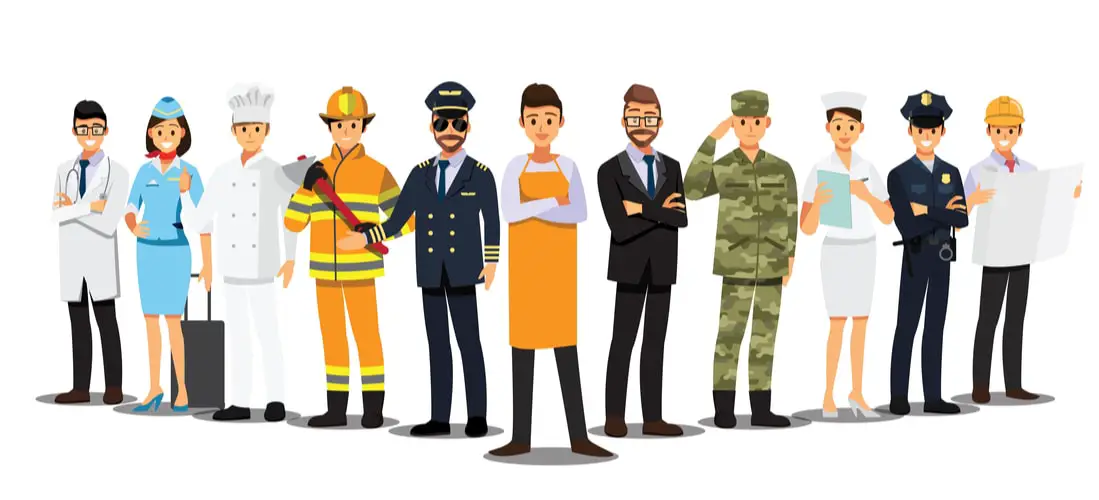Salary, Job Description, How To Become One, and Quiz
.jpg)
ESL Teachers
ESL teachers’ main responsibility is to teach non-English speaking people how to communicate fluently in the English language. They often work in elementary, middle, and high schools, as well as in adult education centers.
Table of contents
An ESL (English as a Second Language) teacher works with ELL (English Language Learners) and students who do not speak English as a first language. They help them become fluent in speaking, reading, and writing English. They can work with children as young as Kindergarten all the way up to adult immigrants who need to learn English.
ESL teachers usually have a college degree and additional certification in teaching English as a second language. They are different from foreign language teachers because they are teaching their students the meaning of the language more than focusing on definitions and grammatical terms.
What they do
ESL teachers’ main responsibility is to teach non-English speaking people how to communicate fluently in the English language. They often work in elementary, middle, and high schools, as well as in adult education centers.
Prepare Course Materials and Design Lessons for Students
It takes effort to make lesson plans for each class, and it is important to have all of the materials you need to teach the class. Young children might need visual aids to help them learn English, while you may have other tools for adults and high school students. The lesson plan includes what you will teach in each class, the activities your students will do, and any assignments.
Normally, you will make a syllabus for the entire semester to show the students what the general plan is. There may be specific guidelines that the state or the school have for the students, so you need to work within these guidelines.
Provide Instruction to Students in Reading, Writing, and Speaking English
This is a very important part of the job. You will provide instruction to all of your students in reading, writing, and speaking English. You might spend your class time with specific conversation topics, or you might have students take turns reading out loud. You can teach face-to-face or online in a conferencing program.
You will teach students who don’t have the fluency of a native English-speaker, so you need to slow down and make sure that they learn the basics first. You need to have good intuition so that you know when your students are feeling lost. This way you can find ways to give them the confidence to continue on.
Evaluate and Assess Students’ Progress
Another responsibility of ESL teachers is to evaluate and assess their students progress as they learn English. They need to be able to determine whether they are developing comprehension and true understanding and modify their plans when it is necessary. The students may be required to reach certain milestones on a specific timeline, and the ESL teacher needs to give updates to the school or other agencies as required.
Lead Students on Field Trips
ESL students also lead students on field trips where they can practice their newfound skills in speaking English. They might have opportunities to use English in a restaurant or a store, and the teacher will facilitate this experience. They can go to museums, libraries, and many other places where they can put the English into the real world.
What is the job like
I was an English Teacher in Japanese public elementary and junior high schools. My Typical Day In Japanese schools, teachers are divided by grade in the teacher’s room. For example, the first grade teachers sit together, the second grade teachers sit together, and so on. Before classes, each teacher group has a 5 to 10 … Read More
My typical day starts at 3:40 am when my alarm goes off. I start teaching my first class at 4 am. Each class is one-on-one with a student in China and lasts for 25-28 minutes. I have a few minutes between each class to grab a refill of tea, do some jumping jacks, or jot … Read More
I’m a private online ESL (English as a second language) teacher. I teach the English language to adults and children from Hong Kong. Hong Kong is eight hours ahead of my time zone, so I work morning hours (their evening hours). My day starts at 8 am, and classes finish at about 2 pm. I … Read More
Pros
You get to meet people from all over the world
When you are an ESL teacher, you interact with students from all over the world. You get to learn about other cultures firsthand.
You can travel to new countries to teach
ESL teachers are in demand in a lot of other countries, and you can travel and see the world.
You will have a lot of job opportunities
There is never a shortage of people who are learning English as a second language, so you will always be able to find an opportunity to get a job.
You can make a difference in people’s lives
Teaching always gives you the ability to make an impact on other people’s lives, and teaching ESL is no different
Cons
You don’t always get benefits
Unless you are teaching as a full-time teacher at a public school, you won’t necessarily have benefits with your job.
You might work odd hours
This is especially true if you teach ESL online to people in another country halfway around the world.
Where they work




ESL teachers can work in public and private elementary, secondary, and postsecondary institutions. They also work at adult education centers. They might work in a classroom or offer online instruction. At times, they even offer private lessons and teach in their homes or in the homes of their students. They might also work in foreign countries such as Costa Rica, Russia, South Korea, and others all over the world.
How to become one
Step 1: Earn a Bachelor’s Degree
You will need to earn your bachelor’s degree in English, writing, ESL, or education. You will learn how to create course plans and teach people from different cultures who speak very little English. This will prepare you for your career.
Step 2: Complete an ESL Training Program
You will learn how to teach English as a second language, how to assess your students’ language skills, and how to practice conversational skills and grammar. This will also provide the qualifications for you to be licensed.
Step 3: Get a License
You need a license for this professional position, and licensing requirements can vary depending on where you want to teach. You will often pass a test for your license at the end of your ESL training program.
Step 4: Apply for Jobs
Once you are licensed, you are ready to apply for jobs. You can choose the setting that is ideal for you. If you want to travel and teach in foreign countries, you might be able to plan and secure jobs in the countries you want to visit.
Should you become one
Best personality type for this career
People with this personality type likes to work with people and in teams. They prefer work that allows them to build relationships with others.
You can read more about these career personality types here.
ESL teachers are confident and detail oriented. They have a lot of patience, and they know how to communicate through body language. They are outgoing and friendly, and they put people at ease. They need to be flexible because classes don’t always go as planned. In addition, they are independent and resourceful; they can think on their feet. They are compassionate and enjoy helping other people. These are all important personality traits for this career.
Take this quiz to see if this is the right career for you.
Don’t know which career to pursue?
Take the career quiz to find careers that match your personality type.
Take The Career Quiz


.jpg)
.jpg)
.jpg)
.jpg)
.jpg)
.jpg)
.jpg)
.jpg)
.jpg)
